OR/18/020 Study area
| R S Ward1, G Allen2, B J Baptie1, L Bateson1, R A Bell1, A S Butcher1, Z Daraktchieva3, R Dunmore4, R E Fisher5, A Horleston6, C H Howarth3, D G Jones1, C J Jordan1, M Kendall6, A Lewis4, D Lowry5, C A Miller3, C J Milne1, A Novellino1, J Pitt2, R M Purvis4, P L Smedley1 and J M Wasikiewicz3. 2018. Preliminary assessment of the environmental baseline in the Fylde, Lancashire. British Geological Survey Internal Report, OR/18/020. |
Geography
The Fylde is a flat, low lying area, forming part of the West Lancashire Plain. It is dominated by the urban centres of Lytham St Annes and Blackpool, but surrounded by agricultural land, both pasture and arable (Figure 2). The topography is mostly flat, ranging from 0–47 mOD, with the Kirkham Moraine forming a subtle topographic high towards the east (Cripps et al., 2017[1]). Two major rivers bound the Fylde: the River Wyre to the north and the River Ribble to the south. Another slight topographic high separates the valleys occupied by these two rivers (Newell et al., 2016[2]). In the area close to PNR, surface drainage comprises mostly small ditches, often with very low flows in the summer months. Marton Mere is the only glacial lake in the area, thought to occupy a kettle hole, and is designated as an SSSI. Across the Fylde are multiple flooded brick pits; small hollows or depressions where clay has previousl
The area has a previous history of hydrocarbon exploration/development and five hydrocarbon wells have been drilled previously across the Fylde (Figure 1). One (Elswick) is classed as a production well, while three are fully abandoned (Preese Hall, Thistleton and Anna’s Road) and plans are in place for abandonment of the fourth (Grange Hill).
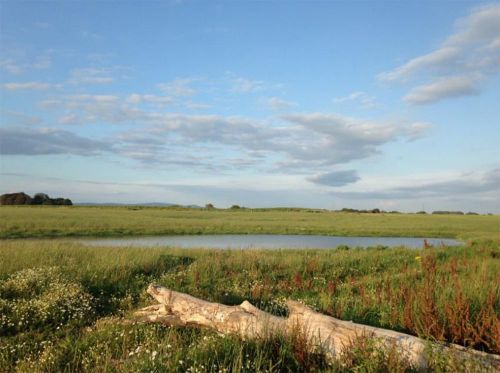
Regional geology
Background information on the Quaternary and bedrock geology of the Fylde is given by Cripps et al. (2017)[1] and Newell et al.(2016)[2], but a brief overview is provided here.
Quaternary geology
The Fylde is dominated by Quaternary-age glacigenic deposits (Figure 3), comprising mostly till (clay-rich), glaciofluvial deposits (sand and gravel) and some glaciolacustrine deposits (clays and silts). These tills, sands and gravels are of variable thickness and lateral extent due to the varying character of depositional environments and physical processes (Cripps et al., 2017[1]). The most widespread unit at the surface is till, with the associated glaciofluvial deposits forming linear outcrops. In general, the sequence broadly comprises a basal till overlain by glaciofluvial sand and gravel, which is in turn overlain by an upper till. There are major local variations to this succession and the units are both laterally and vertically variable, making interpolation of units very difficult.
Holocene deposits occur around Blackpool and in both the River Wyre and River Ribble estuaries. These consist mostly of clays, silts and sands of alluvium and tidal-flat origin. A large area of wind-blown cover sand is present around Blackpool and Lytham St Annes. Areas of peat are also present: at surface occupying a roughly north-south channel east of Blackpool, with some sub-surface layers (2–3 m thick) around Lytham St Annes and Blackpool.
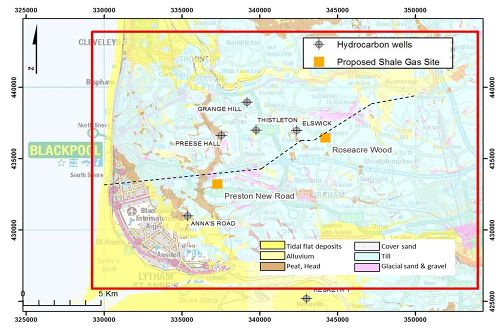

Borehole records show that the thickness of the Quaternary deposits is variable, between 1–86 m, and the sediments thin to the east of the area where the rockhead is closer to surface. The Kirkham Moraine is present between the two Cuadrilla sites. The glaciofluvial deposits are the main aquifer unit in these Quaternary deposits and have also been known as the ‘Middle Sands’ (Worthington, 1972) and defined by the Environment Agency for the purposes of the Water Framework Directive (WFD) as the ‘West Lancashire Quaternary Sand and Gravel Aquifers’.
Close to PNR, borehole records report a confining upper boulder clay ca.10 m thick, comprising alternating sand/gravel and clay layers (forming a shallow aquifer) and then ca.15 m of glacial sands and gravels, forming the main Quaternary aquifer. At Roseacre Wood, the lower boulder clay unit is missing. Instead, ca.15 m of glaciofluvial deposits sit directly on the Mercia Mudstone Group (MMG), and are overlain by an upper unit of boulder clay.
Bedrock geology
In the Fylde, the Quaternary deposits overlie a thick (up to ca.350 m) sequence of Triassic MMG deposits, the latter dominated by mudstone with thin layers of halite and sandstone (Aitkenhead et al., 1992[3]; Wilson and Evans, 1990[4]). These are thickest within the deep graben structure of the Kirkham Basin (Figure 5). The SW–NE-trending Woodsfold Fault is a normal fault with downthrow to the west. To the west of the fault, BGS geological mapping indicates that MMG occurs everywhere at rockhead, although modelling undertaken for this study (see below) suggests that MMG thins or is absent in a section to the north of the Thistleton 1 borehole (Figure 6) (Newell et al., 2016[2]). Below the MMG, the Permo-Triassic Sherwood Sandstone Group (SSG) reaches a thickness of some 750 m.
The Woodsfold Fault forms the eastern margin of the West Lancashire Basin. To the east of the fault, the MMG is missing and the SSG forms the top of the bedrock, underlying Quaternary deposits directly.
The SSG rests on Carboniferous strata, the eroded top of which define the Variscan unconformity. The top of the Carboniferous has considerable relief created by differential movement of fault-bounded blocks. The Kirkham Basin is bounded to the west by a faulted structural high (including the Elswick Dome), where the deep hydrocarbon exploration boreholes Elswick 1 and Thistleton 1 were drilled (Figure 6). Westwards from this high, the top Carboniferous surface dips toward the west under Blackpool and toward the Formby Point Fault which forms the boundary of the East Irish Sea Basin (Newell et al., 2016[2]).
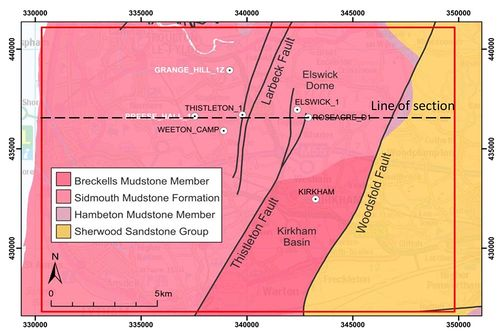

Regional hydrogeology
Quaternary deposits
The glacial sands and gravels are the main aquifer in the Fylde, although they do not form one laterally continuous aquifer unit. In general, the sand and gravel units occur as discontinuous lenses interbedded with clays, and are confined by the upper boulder clay. In areas such as PNR, shallower lenses of sand may be water-bearing, but are separated from the main glaciofluvial (‘Middle Sands’) aquifer by thin clay layers. The variability in the thickness (or presence) of the upper boulder clay will affect the degree of confinement and hence the hydrogeological conditions within the shallow aquifer.
Historically, few investigations have been undertaken on the Quaternary aquifer in this area. The deposit is mostly defined as a Secondary (undifferentiated) Aquifer by the Environment Agency (Figure 7). Where peat or tidal-flat deposits are present, the shallow sediments are defined as Unproductive and the alluvium, blown sands and glacial sands/gravels are classed as Secondary A. These glaciofluvial deposits are used locally by small businesses, farms and golf courses but problems with water quality (mostly iron) and groundwater yields are not uncommon.
Groundwater levels are generally shallow (1–2 m below ground surface) and are artesian in parts, especially in topographic lows located near to surface drainage.
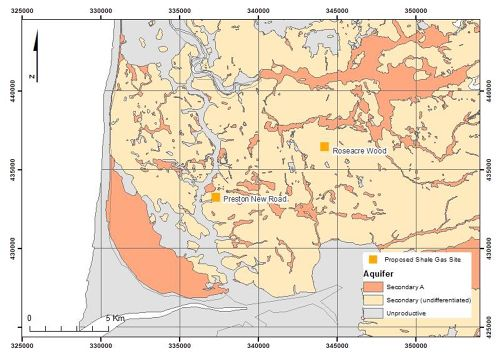
Sherwood Sandstone Group
In the area of the Fylde peninsula (west of the Woodsfold Fault), the top of the Sherwood Sandstone Group occurs at some 370 m depth below surface. This is at too great a depth to be of practical use for water supply. To the east of the Woodsfold Fault, as the SSG is at rockhead (shallow), it is classed by the Environment Agency as a Principal Aquifer (Figure 8) and is used for public water supply.
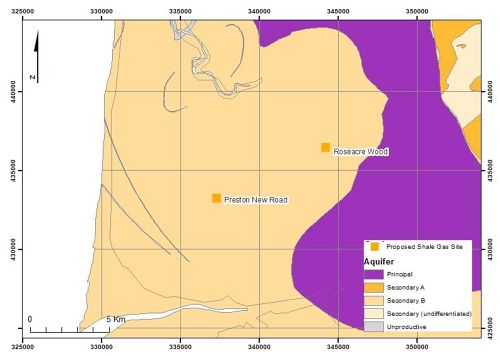
To the east of the Woodsfold Fault, Quaternary deposits cover the SSG, the boulder clay again acting as a confining layer. In areas where the Quaternary deposits comprise sand and gravel, these are in hydraulic continuity with the SSG.
Recharge to the SSG primarily occurs through the Quaternary deposits (Sage and Lloyd, 1978[5]) but also from permeable sandstone and limestone layers in the Carboniferous sequence (Bowland Fells), across the Bilsborrow Fault (Figure 9). Investigations to remap the Fylde SSG aquifer by the Environment Agency in the 1990s identified that the regional groundwater flow direction is from east to west, following the line of topography (Seymour et al., 2006[6]). Main groundwater discharge points are thought to be the River Ribble to the south and River Wyre in the north. However, this is complicated by the occurrence of marl bands within the SSG and N–S faulting, especially near Preston, which can isolate parts of the sandstone and cause local anisotropy. The SSG in this area has a lower porosity and hydraulic conductivity compared to equivalent units in the Midlands as the sandstones of the Fylde tend to be more consolidated and cemented (Seymour et al., 2006[6]).
As part of their groundwater models, the Environment Agency have historically taken the Woodsfold Fault as a regional barrier to groundwater flow, based on the conclusion that there is no juxtaposition along the fault of the deep and shallow SSG aquifer. The contact with the shallow SSG along the fault line is taken to be the MMG (Figure 9). Investigations by Sage and Lloyd (1978)[5] identified that groundwater from the SSG to the east of the Woodsfold Fault discharged through the Quaternary deposits.
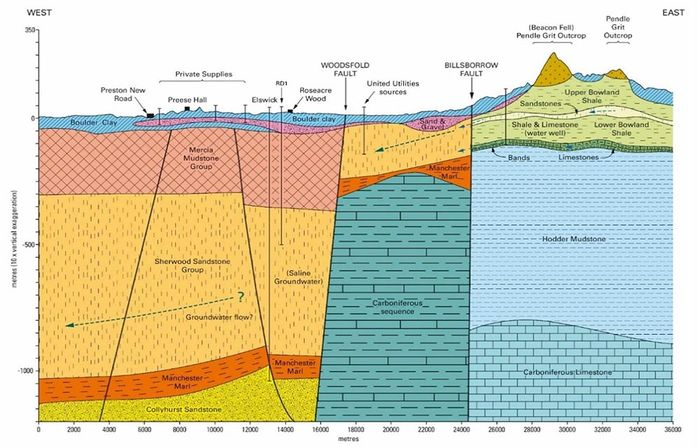
References
- ↑ 1.0 1.1 1.2 1.3 CRIPPS, C, BURKE, H F, LEE, J R, and HOUGH, E. 2017. The Fylde, Lancashire: summary of the Quaternary geology. British Geological Survey, OR/16/013, (Keyworth, UK).
- ↑ 2.0 2.1 2.2 2.3 NEWELL, A J, BUTCHER, A S, and WARD, R S. 2016. A 3D geological model of post Carboniferous strata in the south Fylde area of the West Lancashire Basin, Blackpool, UK. British Geological Survey, OR/16/007, SURVEY, B G (Keyworth, UK).
- ↑ AITKENHEAD, N, BRIDGE, D M, RILEY, N J, and KIMBELL, S F H, LONDON.) 1992. Geology of the Country around Garstang. Memoir for 1:50 000 Geological Sheet 67 (England & Wales). (London: HMSO).
- ↑ WILSON, A A, and EVANS, W B. 1990. Geology of the country around Blackpool. Memoir of the British Geological Survey, Sheet 66 (England & Wales). (London: HMSO).
- ↑ 5.0 5.1 SAGE, R C, and LLOYD, J W. 1978. Drift deposit influences on the Triassic Sandstone aquifer of NW Lancashire as inferred by hydrochemistry. Quarterly Journal of Engineering Geology & Hydrogeology, Vol. 11, 209–218.
- ↑ 6.0 6.1 SEYMOUR, K J, INGRAM, J A, and GEBBETT, S J. 2006. Structural controls on groundwater flow in the Permo-Triassic sandstones of NW England. 169–185 in Fluid Flow and Solute Movement in Sandstones. BARKER, R D A T, J.H. (editor). 263. (London: Geological Society).